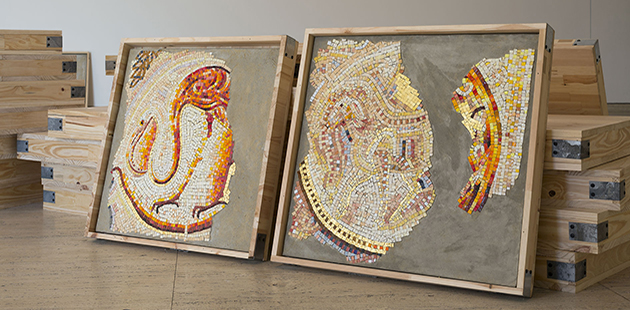 The first large-scale exhibition to survey Melbourne artist Tom Nicholson’s acclaimed drawing, sculptural and social art practice, Tom Nicholson: Public Meeting opens at the Australian Centre for Contemporary Art (AACA) on 6 April 2019 as part of the annual Influential Australian Artist Series.
The first large-scale exhibition to survey Melbourne artist Tom Nicholson’s acclaimed drawing, sculptural and social art practice, Tom Nicholson: Public Meeting opens at the Australian Centre for Contemporary Art (AACA) on 6 April 2019 as part of the annual Influential Australian Artist Series.
Tom Nicholson’s internationally regarded practice explores the relationship between history, collective actions and their traces. A common motif within his work is the notion of the public monument, it’s weight, authority and finality, and also its ability to be questioned, reconfigured and reimagined.
Nicholson works with historical materials and the visual languages of art and politics to create new narratives informed by listening, taking account and giving voice to others, with an insistence on acts of imagination, solidarity and justice.
Curated by ACCA’s Artistic Director Max Delany, Tom Nicholson: Public Meeting brings together key projects from 1999 to the present, alongside new commissions, including:
Towards a monument to Batman’s Treaty 2013-19: Taking its starting point as Melbourne’s first European chimney, built for John Batman by William Buckley, this major installation comprised of over 3,500 bricks and more than one hundred plaques engages the contradictory meanings of the Treaty that Batman claimed he signed with Wurundjeri people in 1835.
Incorporating wide-ranging understandings of the event and its repercussions, and ongoing dialogues with First Nations colleagues, Nicholson offers alternative ideas that challenge inherited histories regarding the foundations of Melbourne’s origins.
Gorge photograph, 13 September 1939 (Battarbee Namatjira) 2017-19: Unfolding as a reimagining of a specific place and time, Gorge Photograph highlights the remarkable relationship of Victorian watercolourist Rex Battarbee with the Western Arrernte artist Albert Namatjira and the critical (and largely overlooked) importance of photography in their personal and professional exchange.
While Battarbee and Namatjira were camped at Kwartatuma/Omiston Gorge in 1939, they received news informing them of the outbreak of WWII. Battarbee, who had suffered greatly in the previous war, was deeply affected by this news, momentarily disabling his artistic production. Nicholson has created a new series of drawings in response to this moment, reimagining the negatives Battarbee might have taken during this time of personal turmoil.
Evening shadows 2011-19: draws together two historic sources to tease out a new narrative lodged within the much-loved Australian landscape painting, Evening Shadows 1880, by H.J. Johnstone – the first work acquired by the Art Gallery of South Australia and the most copied painting in Australia.
Nicholson reanimates this colonial painting in relationship to the historic event known as the Cummeragunja Walk Off of 1939, in which 200 Yorta Yorta men and women crossed the Murray from NSW into Victoria in protest against their treatment at the Aboriginal reserve. In Nicholson’s elaborate installation, the unnamed woman crossing the Murray river at twilight depicted in the original, is no longer a passive figure in the landscape, but a fighter of anti-colonial resistance, acting out a heroic and meaningful action.
Nicholson’s Evening Shadows installation brings together multiple components to tell this story, including the display of the original painting loaned from the Art Gallery of South Australia alongside dozens of copies of the work sourced from a public call-out, as well as video filmed by Uncle Wayne Atkinson recording the 1988 “Walk On”, a gathering commemorating 100 years since the establishment of Cummergunja.
Comparative monument (Shellal) 2014-17: draws on the complex history of the Shellal mosaic, the extraordinary 6th century Christian mosaic uncovered in Palestine by Australian soldiers in 1917, which was subsequently relocated and permanently built into the Australian War Memorial in Canberra.
Comparative monument (Shellal) imagines the repatriation of this Byzantine mosaic and the realities of stolen objects and shifting borders. The Shellal Mosaic later inspired the decoration of the Hall of Memory at the AWM created by artist Napier Waller.
Nicholson takes inspiration from both mosaics by creating a new set of glass-tile mosaics created with mosaicists Rafat Al Khatib and Renan Barham at the Mosaic Centre in Jericho. The mosaics are presented within their crates, mirroring their transport from Palestine, in perpetual transit with no conceivable option for repatriation.
“The figure of the monument is a key motif which recurs in Tom Nicholson’s work, and an engagement with its weight, authority and persistence, and, on the other hand, its ability to be questioned, reconfigured and reimagined,” says Max Delany.
“The verticality of the monument is also set against the horizontality of landscape, which is referenced in the panoramic and cartographic form of much of Nicholson’s work. The figure of the landscape, and significance of land and country, bears an inevitable relationship to the roles of place and displacement, inscription and movement, exile and homecoming that course through the artist’s work.”
Originally trained in drawing, a tradition that deeply informs his practice, Tom Nicholson is one of the most prominent Australian artists on the international stage, and has been included in major international exhibitions including Gwangju Biennale, 2018; Biennale of Sydney, 2006 and 2018; The National, Art Gallery of New South Wales, Sydney, 2017; Museum of Archaeology and Anthropology, Cambridge, UK, 2016; Jakarta Biennale, Jakarta, 2015; the Qalandiya International, West Bank and Gaza, 2012, 2014 and 2016; Shanghai Biennale 2012; among others.
Tom Nicholson: Public Meeting
Australian Centre for Contemporary Art (AACA), 111 Sturt Street, Southbank
Exhibition: 6 April – 16 June 2019
Free entry
For more information, visit: www.acca.melbourne for details.
Image: Tom Nicholson, Comparative monument (Shellal) 2014–17 (detail), glass tesserae mosaics, wooden boxes, dual channel digital video, colour, sound, installation dimensions variable. Collection: Art Gallery of New South Wales. Contemporary Collection Benefactors and Patrick White Fund 2017. Image courtesy the artist – photo by Christian Capurro
